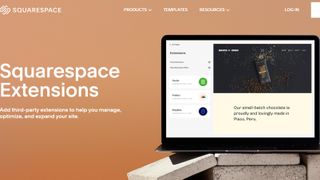How to create a website: a step-by-step guide
This is everything you need to build a website from scratch

TechRadar created this content as part of a paid partnership with Squarespace. The contents of this article are entirely independent and solely reflect the editorial opinion of TechRadar.
There was a time when business owners didn’t need to know or care about how to create a website – that was a job for web developers. Not any more.
With the growing availability of flexible web hosting services, slick website builders, and user-friendly platforms, anyone who needs a website can build a website.
In this article, we’ll show you how to build a website from scratch.
First up, take a look at our simple 9-step guide to the website building process, then find out which platform is suitable for your website.
<a href="https://Squarespace.syuh.net/c/221109/533949/9084?subId1=hawk-custom-tracking&sharedId=hawk&u=https%3A%2F%2Fwww.squarespace.com%2Fwebsite-design" data-link-merchant="squarespace.com"">Squarespace is a top-rated website building platform Techradar editors praise Squarespace for its beautiful templates and professional features. Visit Squarespace.com to <a href="https://Squarespace.syuh.net/c/221109/533949/9084?subId1=hawk-custom-tracking&sharedId=hawk&u=https%3A%2F%2Fwww.squarespace.com%2Fwebsite-design" data-link-merchant="squarespace.com"" data-link-merchant="squarespace.com"">start your free trial.
How to build a website in 9 steps
To understand how to make a website, you should follow 9 simple steps:
- Choose the right website builder or web hosting service for you. For a website builder, we recommend Wix and for a web host provider, we recommend Bluehost.
- Figure out what type of website you want. If it’s a personal or business website, you will need to look into what features and functions you’ll require.
- Pick a plan that suits those needs. Website builders are clever in a sense where they have meticulously separated each plan package to suit the needs of different websites.
- Register a unique domain name. Use a domain name generator to pick a memorable domain name for your website. We recommend Domain.com as it’s a versatile provider that provides great value for your money.
- Pick a template from the website builder you chose. Begin creating and customizing your website. Luckily, most top tier website builders have hundreds of templates to pick from, so you’re bound to find something you like.
- Upload your content. Fill your website pages with products, photos, and text that will drive traffic and conversions.
- Install extensions and plugins. Enhance your business and use add-ons to help customers complete their journey on your website.
- Publish and promote your website. Start sharing your products and services with the world.
- Track and tweak as you go. Analyze your website performance to make sure customers keep coming back.
Why should you create a website
Thanks to social media platforms and marketplace websites, you might think that you don’t need your own site to curate your online presence.
Are you a pro? Subscribe to our newsletter
Sign up to the TechRadar Pro newsletter to get all the top news, opinion, features and guidance your business needs to succeed!
But if you want to access a unique global audience, grow your business at pace, and generate authentic credibility, you need a website.
Whether you just want a few web pages or an impressive online store, websites provide several amazing opportunities, for example:
- You can be in business all day, every day, anywhere in the world
- A website will get you exposure to a vast customer base
- You’ll be able to build a brand
- Websites help to ease customer service queries
- You can experiment with content and brand strategies on your site
- A website adds credibility to your business
- You’re in control and not relying on any third-party platform

How to create a website with Squarespace
1. Pick a template
When you sign up for Squarespace, you'll be asked to choose a template and sign in through Google or continue with your email.
2. Customize your site
You are then free to begin customizing your website with a title, and you'll be given a quick guide to help you navigate through the website builder's dashboard.
3. Secure a custom domain name
You can pick a domain name you've already purchased to make your site unique to your business.
4. Create your website pages
This is where you can get creative and add all the elements you need to create your perfect website. Squarespace lets you add images and pictures, plus it's easy to customize the text.
5. Publish
Once you're happy with your completed design, you can publish your site and spread the word online.
Pros of Squarespace: Essential ecommerce features with most plans, lots of mobile-responsive templates, free trial with no credit card info required, free SSL certificate, helpful 24/7 customer support and well-supplied knowledgebase, and a solid set of features.
Cons of Squarespace: Can't switch templates without starting from scratch, there's no telephone support, and Squarespace has low level of customization.
Best suited for: People with or without experience.
- Read our full Squarespace review

How to create a website with Hostinger
If you’re after web hosting services instead of simply website builders, check out Hostinger. An uncomplicated web hosting option, it offers impressive value for money and industry-leading uptime.
Opt to use web hosts if you’re happy to do a little more work to create a website filled with plugins and premium features. Here are the steps to creating a website using Hostinger:
1. Choose a web hosting plan
Hostinger has 7 web hosting solutions, including plans for WordPress, Cloud, and Minecraft.
2. Select which platform to build your website with
You have a range of options depending on your needs, from Zyro to WordPress to Magento.
3. Register a domain name
The premium and business plans offer free domain options, so this part is made easy.
4. Customize your site
Whether you’re using a site builder or content management system (CMS), create a unique design.
5. Install plugins and extensions
The primary perk of using WordPress, you can pack your website with slick plugins.
6. Upload content and images
With your design style nailed, add pages and even blog posts to your site.
7. Publish and promote
Once you’re happy, it’s time to get your website out there.
Pros of Hostinger: Super reliable web page loading speed and uptime, unlimited bandwidth.
Cons of Hostinger: There’s only live chat, no phone support, for Hostinger’s users.
Best suited for: people with a bit of experience (you don’t have to be a web developer, though).
- Read our full Hostinger review

How to create a website with GoDaddy
Known as one of the largest domain name registrars, GoDaddy is also a web hosting provider, but it boasts its own website builder, too.
Want to know how to build a website with GoDaddy’s site builder tools? Get the tips here:
1. Pick a template
You can choose to build a website or online store. GoDaddy’s template library is generous – enhance the design with stock photos and custom features.
2. Add content and products to your site
With your design theme chosen, fill your website or store pages to wow future customers.
3. Use GoDaddy’s built-in marketing tools
This site builder has a complete marketing suite to get your business off the ground right away.
4. Manage your website
GoDaddy’s InSight tech system allows people to access smart insights about their websites on the go.
5. Purchase premium features as you go
While you can get started with no credit card required, this platform offers design themes and content extras.
Pros of GoDaddy: easy to use, and Windows web hosting is available.
Cons of GoDaddy: lacking advanced features, and an SSL certificate costs extra.
Best suited for: people with low budgets and minimal experience.
- Read our full GoDaddy review

How to create a website using Wix
Wix is one of the most well-known website builders out there. Having created star-studded marketing campaigns, it’s no wonder that Wix has a sophisticated website platform.
If you want to find a way to get online using Wix, follow these steps:
1. Choose your website
When you sign up for Wix, you’ll be asked what purpose your site is being created for, like providing links or selling products.
2. Pick a template
Like Zyro, you don’t need to find a web host when you use Wix, so head straight to their library of jaw-dropping templates.
3. Customize your site
The Wix editor is easy to use: design your website or store pages to impress visitors using the drag-and-drop tool.
4. Add advanced features
Head to the Wix App Market to get some enhancements for your store or website, like booking platforms.
5. Publish
With your design looking fly, and your website primed for search engine optimization (SEO), it’s time to go live.
Pros of Wix: Wix has impressive templates and is flexible and credible.
Cons of Wix: Slow loading times, which your website visitors won’t love.
Best suited for: small and medium-sized business owners.
- Read our full Wix review
Which website building option is right for you?
Whether you use an all-in-one builder or opt for a web hosting company to create your website, it’s vital that you pick a platform that works for you and your business.
Consider what you need as well as what you value. Do you have coding experience? Is your budget small? Are you on a tight schedule?
Here’s a quick summary of the website building options we’ve explored:
For total beginners — Squarespace or Wix will get you a website quickly and easily. Using site builders is the best way to get a website when you have limited experience. All the tools you need are in one place, and you can easily customize your website pages with Wix or Zyro’s drag-and-drop editors to impress visitors from the get-go.
For people on low budgets — GoDaddy or Squarespace are cost-effective platforms for new business owners or individuals who need a way to get online. You won’t pay extra for domain names or web hosts, and the startup costs for Zyro and GoDaddy’s plans are super low.
For small to medium-sized businesses — Wix is a solid option for your business website, and some recognizable brands already use the platform. If you’re selling products or want clever booking features, Wix will provide you with the toolkit to make that happen on your website.
For large businesses and complex needs — Hostinger has an impressive number of hosting options for creating a business website. Whether you build with WordPress or a builder like Zyro, Hostinger makes sure that your business will enjoy a fast-loading, responsive website with every typically complex part of the process taken care of.
- We've also featured the best website builder

Désiré has been musing and writing about technology during a career spanning four decades. He dabbled in website builders and web hosting when DHTML and frames were in vogue and started narrating about the impact of technology on society just before the start of the Y2K hysteria at the turn of the last millennium.

